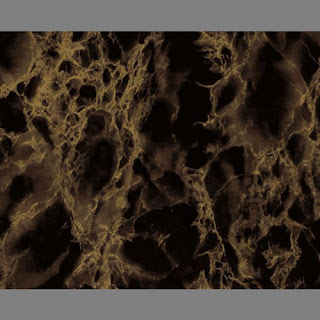
Hello,
I saw some of your online videos and was deeply impressed.
I am working on a reception counter, and I was wondering
how I would go about doing a gold marble with kind of a 3D
effect as shown in the attachment. I really really need your
help.
Thank you so much,
Ken
Ken
You don't give me any idea of the level of skills you have.
The photo you have sent is typical of marble, whether it's real or painted, it has that translucent, you can see just so far into or below the surface of the material. You call it a 3D effect.
Whatever marble, whatever colour you want to create to be a marble effect it must have a '3D effect'.
We're lucky, the sample has a dark background. Dark colours tend to recede where light colours will advance.
If your brief is to copy a particular piece of marble then first find the darkest colour in the sample and paint the background with it.
Find the lightest and that is your final veining colour.
Mix a small amount of the lightest colour with the darkest and create a cloud effect, some cloud shapes with hard edges some without. Parts of the clouds must look like they are disappearing into the background. Create a heavy vein on top of the clouding with a colour lighter than the clouding. Create a second vein lighter and sharper than the last and finally, with the lightest colour and only on the last vein a sharp small vein.
If it is going on a reception counter then the finish will need protecting.
Hope this helps
Fred
Thank you for your help!
As you probably have noticed, I am a beginner. I just started practicing faux a couple of months ago. I drew in some of the clouds but I am having a lot of trouble with the veining. I am working with water based paint and it seems really difficult to do the veining. Maybe I just need a lot of practice.
Thank you,
Ken
As you probably have noticed, I am a beginner. I just started practicing faux a couple of months ago. I drew in some of the clouds but I am having a lot of trouble with the veining. I am working with water based paint and it seems really difficult to do the veining. Maybe I just need a lot of practice.
Thank you,
Ken
Ken
It is difficult with oil based but bloody difficult with water based.
Are you using acrylic tube colours? or ready mixed. It is best I think to
mix your own.
Try and experiment with tube colour and glycerine or KY jelly. Use a pure
sable or kolinsky hair number 4 or 6, depending on the size of vein. Roll
the brush between the thumb and forefinger at the same time moving over the
surface.
If this all sounds a bit confusing then give us a call back.
Fred
It is difficult with oil based but bloody difficult with water based.
Are you using acrylic tube colours? or ready mixed. It is best I think to
mix your own.
Try and experiment with tube colour and glycerine or KY jelly. Use a pure
sable or kolinsky hair number 4 or 6, depending on the size of vein. Roll
the brush between the thumb and forefinger at the same time moving over the
surface.
If this all sounds a bit confusing then give us a call back.
Fred
